② 中国科学院地质与地球物理研究所, 新生代地质与环境重点实验室, 北京 100029)
Silk和Barnes [1]首先在1959年显微镜下观察到裂变径迹,随后到1964年,Fleischer和Price [2]首先对Libyan玻璃进行裂变径迹的测试工作。而磷灰石被广泛地应用于裂变径迹的测试,主要因为:1) 结晶良好;2) 铀含量丰富(1~1000 ppm)且在颗粒中分布均匀,238 U裂变后形成的自发径迹容易识别和计数;3) 在各类岩石中出露广泛[3~5]。此外,磷灰石在进行化学蚀刻的时候,其处理过程也相对简单,光学特征突出。磷灰石的裂变径迹在压力和破碎过程中依然能很好的保存。除了以上技术上的特点外,需求是磷灰石裂变径迹广泛应用的另一个重要原因,例如:磷灰石裂变径迹封闭温度较低,自然界中与有机质“生油窗”基本一致,可以应用于有机质烃源岩评价[6~8];由于封闭温度低,适合于研究地壳浅层(近地表 4~3km范围内)构造活动的时间和幅度,是新构造以及构造地貌学研究的重要技术支撑[9~21]。
造山带的长时间演化与构造、地表侵蚀和沉积过程相互耦合[22]。低温热年代学方法可以对造山带隆升的时空演化进行研究[23~26]。然而,基岩低温热年代学分析只能提供原位的热构造事件发生的时间。与之相反,如果位于造山带附近的前陆盆地内的碎屑沉积物没有经历掩埋加热,沉积物的低温热年代学能反映源区长时间的构造隆升过程。但是,假如这些碎屑沉积物经历显著的加热后,形成的年龄代表了地层抬升剥露的时间[27~31]。通常情况下,无论是基岩隆升,还是碎屑沉积地层的再抬升,出现的“拐点”(breaking point)具有重要的地质意义[31, 32]。如今,低温热年代学已经被广泛的应用于山体隆升、限定潜在物源区、沉积盆地后期的抬升时间等方面的研究。正因为如此,本文从磷灰石裂变径迹的年龄形成机制、封闭温度、径迹退火这些基本概念入手,归纳总结了碎屑和基岩磷灰石裂变径迹年龄出现拐点的地质意义。
2 磷灰石裂变径迹年代学原理 2.1 裂变径迹形成机制“裂变径迹”是母体裂变过程中产生高速、带电的碎片对矿物晶格(磷灰石、锆石和榍石等)造成的电离损伤[2]。“裂变径迹”具体的形成过程如下(图 1):(a)裂变的过程是通过带电原子的裂变碎片沿其路径导致电离作用引起原子离开初始位置;(b)带正电的离子相互排斥,创建一个圆柱形的无序结构,并最终形成了宽约10nm(1nm=10-9 m)的应变区(辐射损伤),即为裂变径迹区;(c)随着时间推移和温度的升高,阳离子回到原来的位置,使辐射损伤愈合,发生“回弹”现象。形成裂变径迹的能量取决于电离离子的质量和介质的密度。

|
图 1 在绝缘体表面裂变径迹形成的过程示意图[2] (a)电离作用下,带电原子(圆圈)发生位移;(b)带正电的离子(圆圈里+号)相互排斥,创建一个圆柱形的无序结构;(c)随着时间推移,阳离子(圆圈里+号)回到原来的位置,使辐射损伤逐渐愈合 Fig. 1 Simplified scheme for the formation of a fission track according to the ion explosion spike theory [2]. (a)A 238 U nucleus fissions, projecting two high-energy fission fragments (circle)through the lattice; (b)ionization, coulomb explosion and subsequent elastic relaxation create a permanent trail of lattice damage(circle with +); (c)as time goes by, the positive ion (circle with +) returns to its original position, and the radiation damage is gradually healed |
天然放射性元素在发生自发裂变时,裂变核分裂成运动方向相反、质量相近的两个裂片。由于裂片获得的动能与其质量成反比,因此裂片越轻,其能量越大,在矿物中的损伤密度越小[5]。自然界中能发生自发裂变的元素主要有铀(U)和钍(Th)。其中,在铀的3种同位素中(238 U、235 U和234 U),238 U的半衰期是最短的,自发裂变的速率最大,所以相对丰度达到了99 %以上,在矿物中形成的潜径迹几乎都是238 U自发裂变径迹[5]。
2.2 磷灰石裂变径迹封闭温度Dodson [33]根据Rb-Sr和K-Ar放射性同位素的研究提出了“封闭温度”的概念,将时间与温度联系了起来,因而不但可以指示温度的变化,而且可以记录时间变化,极大的推动了热年代学的发展[34]。封闭温度定义为热年代体系的表观年龄的温度,即矿物在一个有效封闭温度下放射性同位素开始计时[35]。对于低温封闭体系来说,在高温下子体丢失的速度很快,不能在矿物中富集,因而计时时钟并不能启动;矿物可以在高于、等于或低于封闭的温度下生长。一般只有在低于封闭温度时,矿物才给出生长年龄,否则只给出冷却年龄。随着温度的下降,子体丢失的数量开始变慢,直至子体开始在矿物中富集,此时计时时钟开始启动。对于磷灰石裂变径迹来说,当温度下降到110±10℃时,径迹开始逐渐形成,因而其属于低温热年代学的范畴[34]。
以“封闭温度”理论为支撑,山体基岩区近地表先抬升到封闭温度之上,从上往下矿物依次通过封闭温度等温面,因此裂变径迹年龄从下往上逐渐变大[36, 37]。在山体剥蚀的过程中,顶部最先遭受剥蚀,经河流搬运最先进入盆地。因此在盆地中没有变形、倒转的地层,裂变径迹年龄下老上新,与临近山体年龄成镜像关系[32, 38](图 2)。

|
图 2 山体隆升与盆地沉积之间的时间序列的镜像关系示意图[38] Fig. 2 Mirror-image relationship between the mountain uplifting and basin depositing |
磷灰石裂变径迹在开始形成时具有一个稳定的初始长度,但随着温度的升高,径迹会发生变短,使径迹密度减小,样品的裂变径迹年龄变得更年轻,这种现象称为裂变径迹的退火[2]。
研究人员在室内实验中对磷灰石进行了径迹长度的退火实验,发现随着实验温度和时间的增加,蚀刻后的径迹长度(l)和密度(ρ)发生逐渐衰减的现象[39]。实际中,Gleadow等[40]对澳大利亚东南部的Otway盆地钻孔中的碎屑磷灰石裂变径迹进行分析,结果发现在深度>3000m时,地热温度超过了120℃,颗粒中几乎没有径迹的出现,径迹平均长度接近于零。因而磷灰石裂变径迹的保存深度从浅到深依次为:未退火带,地层尚未受到退火作用,其年龄反映物源区最后一次遭受热历史的时间,大于或等于地层年龄;部分退火带,地层已受到退火作用,其年龄逐渐减小,小于地层年龄;完全退火带,其年龄等于零,地层达到完全退火[40, 41](图 3)。
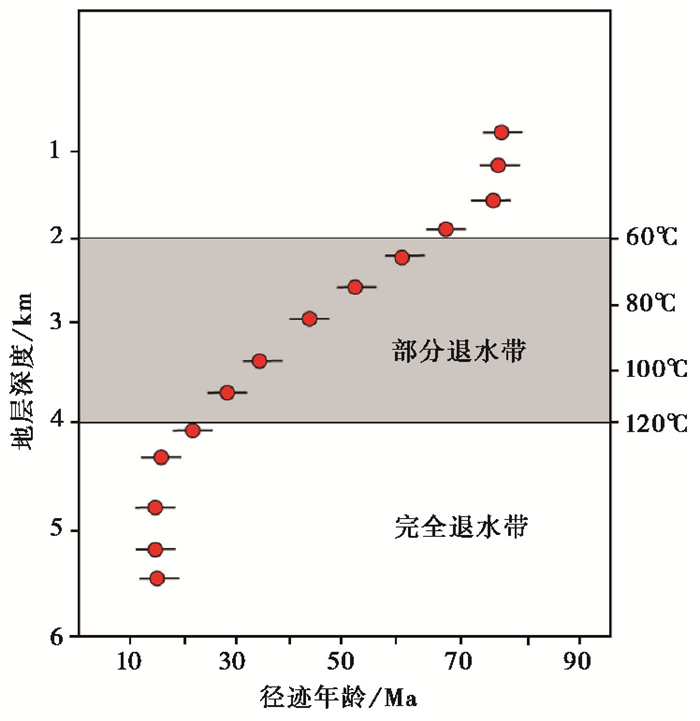
|
图 3 磷灰石裂变径迹退火带示意图[40] Fig. 3 Schematic map showing the relationship between hydrocarbon maturity and apatite fission track annealing belt |
在碎屑磷灰石裂变径迹研究中,滞后时间(lag time)等于碎屑颗粒的最年轻的年龄组分与其所在地层的沉积年龄之差[32]。假设这一时间差与基岩颗粒自封闭温度到抬升至地表的时间是接近的,暴露于地表后经过剥蚀进入盆地中的时间是可以忽略不计的[32, 42]。利用软件可以将碎屑磷灰石裂变径迹的初始年龄组分按照由年轻到古老划分开来,形成P1、P2、P3…等峰值年龄,其中P1代表最年轻的峰值年龄[32]。滞后时间越短,对应于源区发生了快速的隆升过程,反之,则说明源区经历了缓慢的隆升过程[42]。然而,较长的滞后时间也可能是因为快速隆升引起的,古老的年龄很有可能是之前穿过部分退火带后,未快速剥蚀掉而继续停留在此区域内,直至后期再发生快速隆升过程将其暴露出来[43]。
最年轻峰值年龄从沉积地层的下部向上逐渐变小,称为动态峰[32]。而较老的峰年龄相对比较稳定,不随沉积年龄变化,称为静态峰。静态峰可以用于制约沉积源区[42]。因而,最年轻峰值年龄与沉积地层之间的变化特征,主要可归结为以下3种情况[43](图 4):(a)此类型中,P1年龄逐渐减小,滞后时间自底部向上逐渐变短,被认为是属于移动峰(见图 4a),代表了源区快速剥蚀的阶段;(b)此类型是年龄组和沉积层的年龄变化是一致的且不断变年轻,滞后时间自底部向上没有明显变化(见图 4b),这种情况也可以成为移动峰,山体隆升与盆地堆积达到了相对平衡的状态;(c)此类型中,滞后时间在某一点开始出现一致的情况,自底部向上滞后时间逐渐变长,这时区域的剥蚀速率开始变慢,出现了静止型的年龄峰值(见图 4c)。最年轻峰值年龄随沉积年龄变化不大。这种源区的露头现在还可能保持着与碎屑颗粒裂变径迹峰值年龄相当的冷却年龄[44]。

|
图 4 碎屑磷灰石径迹年龄与沉积地层的滞后时间变化样式图[43] (a)滞后时间自底部向上逐渐减小,代表了源区快速剥蚀的阶段;(b)山体隆升与盆地堆积达到了相对平衡的状态,滞后时间自底部向上没有明显变化;(c)自底部向上滞后时间变长,这时区域的剥蚀速率开始变慢 Fig. 4 Schematic lag-time plots based on fission track peak ages and depositional ages. (a)The lag time gradually decreases from the bottom to upper, indicating of the stage of rapid erosion of the source region; (b)the uplifting of the mountain and the accumulation of the basin reached a relatively balanced state, and the lag time was not significantly changed; (c)the lag time get longer and longer from the bottom to upper, and the denudation rate begin to slow down |
最年轻峰值年龄与沉积地层之间的变化特征,除了以上罗列的典型样式以外,还有以下几种主要的类型(图 5):(a)最年轻峰值年龄在地层的下部和上部分别以移动峰的形式出现。当地层底部的移动峰结束后,又出现了另外一段移动峰的特征,这代表物源区发生改变[44]。在两段移动峰衔接的部位,形成拐点;(b)当最小峰值年龄以移动峰的特征出现时,同时在地层的上部最小峰值年龄突然变老,年龄趋势线发生转折形成拐点,代表盆地中有再循环的物质加入或源区的改变[42];(c)当地层底部的磷灰石裂变径迹发生完全退火,年龄清零;地层后期又遭受区域内的活动断层的改造发生抬升,脱离完全退火带出现新的径迹,这时形成的新年龄比较集中,代表了地层因变形发生抬升的时间。地层上部处于部分退火带,年龄自下向上随着经历退火的减弱而逐渐变老,与完全退火带内的年龄的衔接部位形成拐点[27~29, 45]。

|
图 5 碎屑磷灰石径迹年龄与沉积地层的滞后时间变化样式图 (a)地层中出现了两段移动峰,代表了源区的改变[44];(b)地层底部以移动峰为特征,上部最年轻峰值年龄突然变老,代表物源区的改变或者古老物质的再循环[42];(c)地层底部最年轻峰值年龄相近,代表了地层发生变形的时间[27~29, 45] Fig. 5 Schematic lag-time plots based on fission track peak ages and depositional ages. (a)There are two moving peaks in the sedimentary layers, representing the changing of the source area; (b)the lower strata are characteristics of the moving peaks, and the youngest peak ages suddenly grow old in the upper parts, suggesting that the provenance had been altered or the recycling of the old material occurred; (c)the youngest peak ages are centered on a approximate age in the lower strata, representing the time of strata deformation took place |
基岩磷灰石裂变径迹年龄与高程的对应关系研究(age-elevation)是磷灰石裂变径迹实际应用的重要方面之一[23, 25, 26]。在基岩中,处于完全退火带之上的磷灰石逐渐被抬升到更高的海拔,所以在一个山体的基岩垂直剖面上,如果海拔间距足够大,径迹年龄理论上是渐次向高海拔递增,出现了海拔升高,径迹年龄变大的线性相关关系[46](图 6a)。如果一期热事件发生过后,岩体经历了逐渐冷却的过程也可以形成图 6a中的年龄与高程的对应关系。山体经历持续的快速隆升(冷却)过程,当磷灰石颗粒通过部分退火带,并持续一个阶段,这时的磷灰石裂变径迹年龄彼此十分接近,代表了一期冷却抬升事件的发生,各个年龄点的斜率的延伸线与Ⅹ轴的交点,可以大体估计抬升事件发生的时间(tf)(图 6b)。当岩体经历了快速冷却之后,随后的隆升并没有再持续进行,而是以稳定的剥蚀为主,这时可以看到一个部分退火带的出现(图 6c),指示山体进入了构造隆升寂静期,在部分退火带的底部刚形成的年龄最年轻,随着高度增加年龄开始增加,斜率十分平缓。而在上部则出现与图 6b中十分相像的情形,上下两部分的衔接部位存在明显的拐点。

|
图 6 基岩磷灰石裂变径迹年龄与海拔的对应关系图[46] (a)山体持续隆升,隆升速率可以通过求取直线斜率θ得出;(b)当磷灰石颗粒迅速的通过部分退火带,并持续一个阶段,形成的冷却速率斜率变得接近垂直,其趋势线与横坐标的交点tf则代表一期冷却抬升事件的发生;(c)岩体经历了快速冷却之后,随后的隆升并没有再持续进行,而是以稳定的剥蚀为主,部分退火带开始出现 Fig. 6 The map illustrating the relationship between the bedrock apatite fission track age and the relative altitude. (a)Age-elevation plot giving a denudational profile. The slope(θ)can give a true or apparent denudation rate; (b)in case of rapid cooling the slope in an age-elevation plot will be steep, almost vertical. The intercept with the time-axis in this case will yield a formation age(tf); (c)after the rapid cooling of bedrock, the subsequent uplift and no longer continue, but with a stable erosion dominated, partial annealing zone began to appear |
利用碎屑磷灰石裂变径迹最小峰值年龄与沉积地层的相关关系,来限定物源区隆升时间的研究,主要利用了前文介绍的图 4a中的原理。Bullen等[47]利用西天山楚盆地内Ala Archa河剖面的沉积相变化、碎屑磷灰石裂变径迹、古地磁年代学结果,限定塔吉克斯坦境内天山新生代的隆升时间(图 7)。碎屑磷灰石裂变径迹的分析结果出现了年轻的移动峰和古老的移动峰,最年轻的峰值年龄从底部的165Ma到最上部的17Ma,说明整个西北天山在侏罗纪到中新世晚期均处于构造寂静时期,直到中中新世快速隆升开始出现,大量古老年龄保留在部分退火带内,随后经历地表剥露而被搬运到楚盆地。
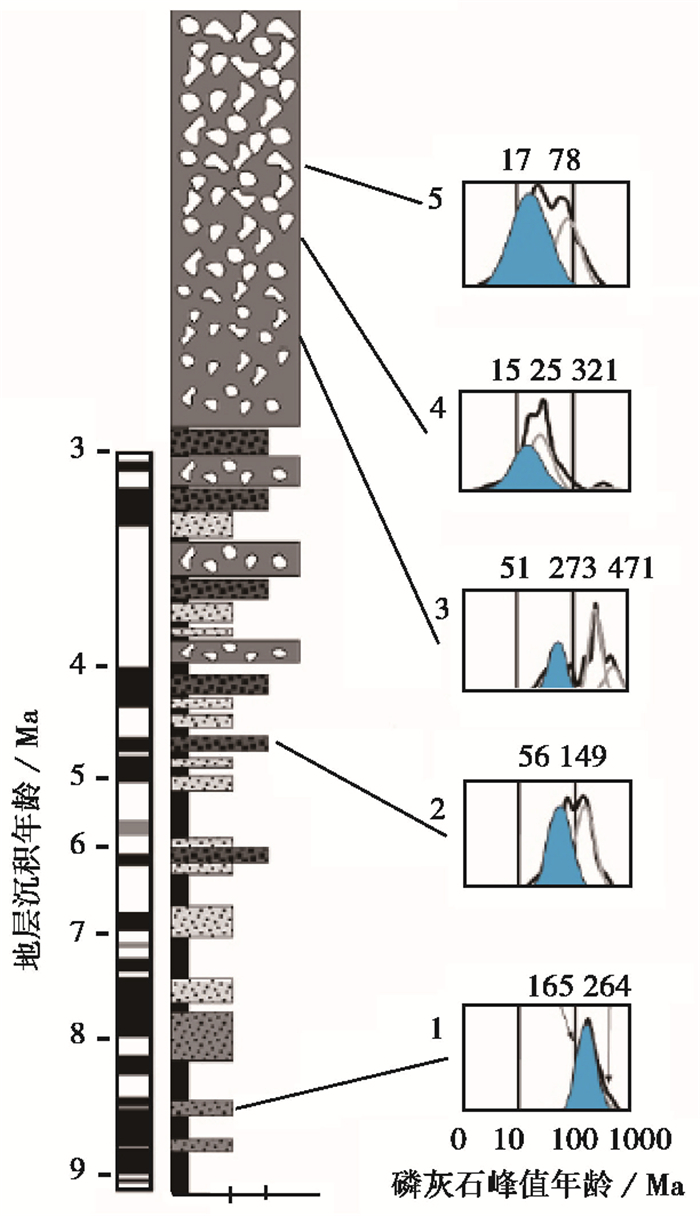
|
图 7 塔吉克斯坦楚盆地碎屑磷灰石最小峰值年龄与地层沉积年龄的对应关系图[47] 阴影部分代表最年轻峰值年龄 Fig. 7 Plot of apatite fission-track youngest peak age against depth for all samples from the Chu Basin of the Republic of Tajikistan. The shadow parts represent the youngest peak ages |
位于安第斯山脉中部高原Puna盆地的Geste组碎屑砂岩中的磷灰石裂变径迹最年轻峰值年龄(蓝色标识)限定的安第斯山中部隆升的起始时间为约52Ma,此后一直经历隆升过程并持续到约35Ma [48](图 8)。

|
图 8 安第斯山脉Puna盆地的Geste组碎屑砂岩磷灰石裂变径迹峰值年龄与地层年龄对应关系图[48] 用圆圈、正方形、菱形和三角形分别代表第一峰值年龄(P1)、第二峰值年龄(P2)、第三峰值年龄(P3) 和第四峰值年龄(P4) Fig. 8 Plot of apatite fission-track peak age against depth for all samples from the Geste section from the Puna Basin in the Andes Mountains, using the circle, square, diamond and triangle represent the P1, P2, P3 and P4, respectively |
利用碎屑磷灰石裂变径迹最小峰值年龄与沉积地层的相关关系,来限定地层内的物源改变的研究,主要利用了前文介绍的图 5a和图 5b中的原理。例如,郑德文等[49]对青藏高原北东缘的临夏盆地内的王家山和毛沟剖面进行的碎屑磷灰石裂变径迹分析,同时结合地层已建立的古地磁年代序列,对区域内构造活动发生的时间进行限定(图 9)。在径迹分解年龄与地层时间对应关系图中,约13Ma地层中的最小峰值年龄迅速减小,相对应的滞后时间也明显减小,表明临夏盆地源区的剥蚀速率迅速加快;在11Ma后,地层中的最小峰值年龄突然变老,物源发生变化(图 9)。
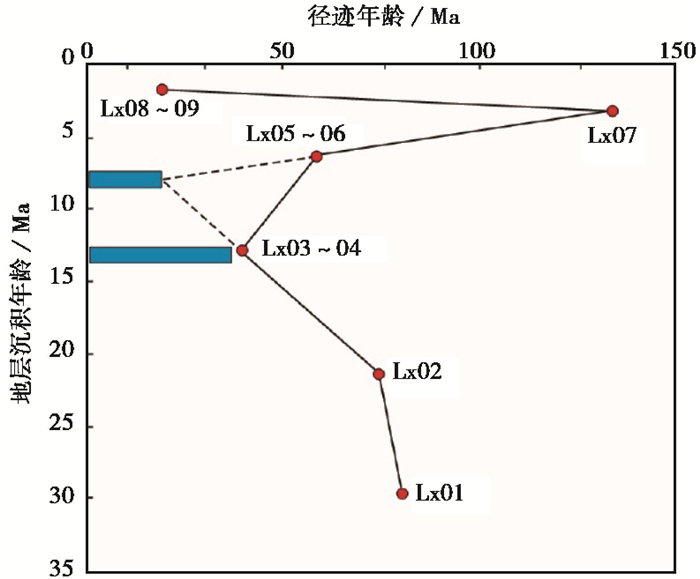
|
图 9 临夏盆地王家山和毛沟剖面碎屑磷灰石裂变径迹分解年龄与地层年龄对应关系图[49] Lx01~Lx09代表样品号 Fig. 9 Apatite fission-track lag time plot for samples from Wangjiashan and Maogou sections from the Linxia Basin, the Lx01~Lx09 represent the sampling numbers |
祁连山北坡的老君庙剖面,最年轻年龄组分的变化趋势在约10Ma发生转变;10Ma之后,滞后时间逐渐增大到约63.5Ma,这表明约10Ma时源区发生显著的变化[50](图 10a)。在红柳峡地层下部(图 10b),约12~8.5Ma之间,最年轻的年龄组分从最老的42.3Ma逐渐减小到13.1Ma;沿地层向上,最年轻年龄组分从约8.5Ma时的13.1Ma逐渐增加到约4.5Ma时的最大值58.3Ma。这一最年轻年龄组分的突变,也可能是源区变化的一个证明。
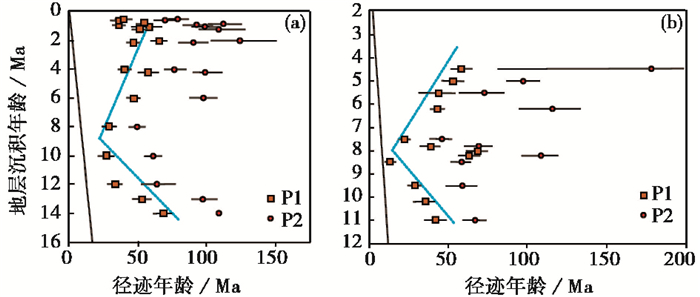
|
图 10 老君庙剖面碎屑颗粒裂变径迹组分年龄随沉积年龄变化(a) [50]和红柳峡剖面碎屑年龄组分随沉积年龄变化(b) [50] P1和P2代表第一峰值年龄和第二峰值年龄 Fig. 10 Apatite fission-track lag time plot for samples from the Laojunmiao (a) and Hongliuxia (b) sections from the northern Qilian Shan. The P1 and P2 represent the first and second peak ages |
Glotzbach等[51]对阿尔卑斯山的前陆盆地中的碎屑沉积物中的磷灰石的裂变径迹进行分析,结果发现地层中分为上下两部分移动峰。自10Ma开始,碎屑磷灰石裂变径迹的滞后时间为6Ma,当地层沉积时间为3Ma时,滞后时间突然增加到13Ma,这指示了盆地的物源区发生了变化或者是有新的物源加入(图 11)。
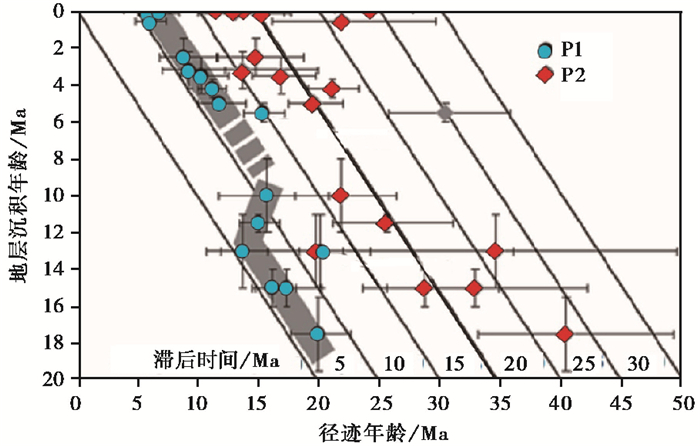
|
图 11 阿尔卑斯山前陆盆地碎屑砂岩磷灰石裂变径迹峰值年龄与地层年龄对应关系图[51] P1和P2代表第一峰值年龄和第二峰值年龄 Fig. 11 Apatite fission-track lag time plot for samples from Chambaran Basin in western Alpine foreland. The P1 and P2 represent the first and second peak ages |
Lin等[52]对党河南山西端的肃北盆地内的铁匠沟新生代剖面进行的碎屑磷灰石裂变径迹分析,结合已有的古地磁磁性地层年龄[53],发现在约14Ma时地层上下两部分的磷灰石裂变径迹最小峰值年龄都具有移动峰的特点,结合沉积速率在此之后开始变快,认为党河南山西端在中中新世的快速隆升是引起这一物源变化的决定性因素(图 12)。

|
图 12 肃北盆地铁匠沟剖面碎屑砂岩磷灰石裂变径迹年龄与地层沉积年龄相关关系图[52] P1、P2和P3代表第一、第二和第三峰值年龄;D1、D2和D3代表年龄趋势线;AKS1~AKS8代表样品号 Fig. 12 Apatite fission-track lag time plot for samples from Subei Basin in Northwestern China. The P1,P2 and P3 represent the first,second and three peak ages. The D1,D2 and D3 represent the age trending lines. The AKS1-AKS8 represent the sampling numbers |
利用碎屑磷灰石裂变径迹最小峰值年龄与沉积地层的相关关系,来进行地层变形、抬升时间的研究,主要利用了前文介绍的图 5c中的原理。准噶尔盆地南部的玛纳斯河中-新生代沉积地层中样品M1的径迹年龄为约186Ma,老于其所在的沉积地层的年龄(约80Ma) [30](图 13)。平均径迹长度为12.4μm,要比靠近地表的样品中的径迹长度15.5~14.5μm短。这说明样品M1所在地层在抬升前经历过退火过程。埋藏最深的3个样品M3、M4和M5的年龄比较相近,集中在约24Ma,这些样品经历了强烈的退火过程,因而推断地层受到山前断裂的影响发生变形再次抬升的时间在约24Ma以前。

|
图 13 天山北坡玛纳斯剖面碎屑磷灰石裂变径迹年龄与地层年龄对应关系图[30] M1~M5代表样品号 Fig. 13 Apatite fission-track lag time plot for samples from the Manas section from the northern Tian Shan Mountain. The M1~M5 represent the sampling numbers |
Peter等[28]对尼泊尔中-西部的中新世到上新世的西瓦里克组群的沉积层进行碎屑锆石和磷灰石裂变径迹分析。沉积层最底部的样品发生了显著的退火行为,发现底部样品形成的年龄集中在约2Ma,代表了西瓦里克盆地北缘的山前逆冲带的活动引起地层变形的时间(图 14)。

|
图 14 尼泊尔西瓦里克盆地碎屑磷灰石裂变径迹分解年龄与地层年龄对应关系图[28] Fig. 14 Plot of apatite fission-track central age against depth for all samples from the Karnali section from the Siwalik Basin |
Zheng等[27]对六盘山断层上盘的早白垩纪沉积层的碎屑磷灰石进行裂变径迹分析,结果表明位于剖面6.1km以下的样品L-6到L-10,5个样品的径迹年龄基本一致(8.2~7.3Ma),平均径迹长度12.74μm,同时χ2检验全部通过,显示单一的年龄组分。这表明样品L-6到L-10经历了“清零”,后期形成的年龄代表了青藏高原东北缘在晚新生代时期向北东缘扩展,引起六盘山山前逆冲断裂发生活动的时间(图 15)。
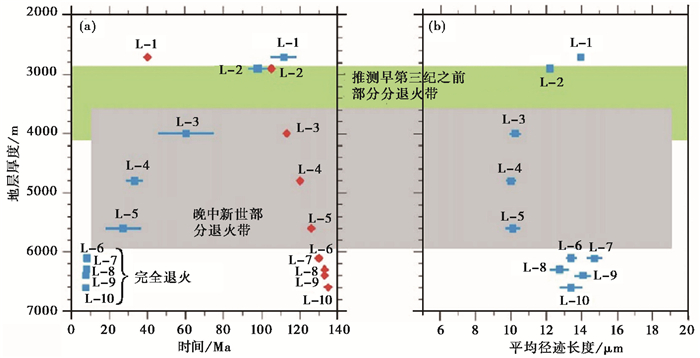
|
图 15 六盘山剖面中-新生代地层碎屑磷灰石裂变径迹分解年龄与地层年龄对应关系(a) [27] (a)正方形代表径迹年龄,菱形代表地层年龄;(b)正方形代表平均径迹长度 Fig. 15 Plots of apatite fission-track lag time plot for samples (a) and confined track length versus the paleo-depth (b) from the Liu Pan Shan from the northeastern Tibetan Plateau. (a) The square and diamond present the apatite fission track ages and sedimentary ages; (b)the square presents the mean length of fission track |
利用基岩磷灰石裂变径迹年龄与高程的相关关系,进行岩体抬升时间的研究,主要利用了前文介绍的图 6中的原理。Gleadow和Fitzgerald [54]在研究南极洲的Transantarctic山脉的Doorly剖面,通过磷灰石裂变径迹年龄与相应的海拔高程之间的对应关系发现明显的拐点出现在海拔800m。拐点之下的径迹年龄较为接近,均集中分布在约50Ma,平均径迹长度约14μm,且分布较窄,因而推断Transantarctic山脉在50Ma时发生快速的隆升事件(图 16a)。在800m以上的岩体内的径迹长度平均为13μm,径迹年龄较为分散,既有古老年龄也有年轻年龄,代表一个古老部分退火带的出现。在该情形下,会发生两次显著的隆升过程,第一期的隆升事件发生之后下面的岩体内会出现部分退火带(图 16b)。上部岩体持续隆升,下部部分退火带内及以下的岩体进而发生隆升,形成了相对于之前的古老部分退火带的新部分退火带,发生了第二期隆升事件。当抬升的古老部分退火带被发现,意味着岩体的地表剥蚀并不充分没有将这一古老的部分退火带完全剥蚀掉,但第一期快速的隆升事件的磷灰石颗粒大部分被剥蚀掉进入到临近的盆地内。在古老部分退火带的下部新一期的冷却事件发生,这时与上部的古老部分退火带的衔接部位将出现明显的拐点。

|
图 16 磷灰石裂变径迹年龄与高程对于关系示意(a) [54]和隆升的古老部分退火带形成示意(b) [54] 拐点出现的时间在约50Ma,将趋势线分为两部分 Fig. 16 Apatite fission track age-elevation profile from the Transantarctic Mountains (a), a clear break-in-slope is observed around 50Ma, dividing the plot in a steep lower part and a more gentle sloping upper part; theoretical concept of the uplifted partial annealing zone profile (b) |
在碎屑磷灰石裂变径迹中,其最小径迹年龄与地层沉积年龄之间的变化关系多样,可分为移动峰、动态移动峰和静止峰3种典型的类型。动态移动峰在实际研究中并不多见,而移动峰根据其变化特点,还可以再划分为两阶段和单阶段移动峰,结合径迹年龄“拐点”出现的地层时代,这两类移动峰主要应用于限定物源变化的时间。而单阶段的移动峰如果出现明显的年龄拐点,在拐点以上的年龄近似一致,则可用来约束潜在的源区。地层中的磷灰石经历完全退火后新形成的径迹年龄,与上部地层未发生退火的古老年龄衔接的部位构成的拐点,可用于限定地层发生变形的时间。
在基岩中,岩体经历逐渐的冷却过程,可形成年龄与高程的对应关系,即高海拔对应径迹年龄大,低海拔对应的年龄小,而径迹年龄拐点的出现主要根据岩体隆升的快慢。快速隆升形成的径迹年龄与部分退火带的径迹年龄形成组合。岩体经历快速隆升,在一定高程范围内的径迹年龄彼此接近,与早期和其后来再出现的部分退火带内的径迹年龄相接的部位会出现上下两个拐点,但早期形成的部分退火带的物质被剥蚀掉,则只能看到其下部的拐点。
由于沉积地层的层序被破坏、地质构造的复杂性以及地热梯度垂向上的突然变化等方面的影响因素的存在,在碎屑和基岩磷灰石径迹年龄的拐点并不存在,因而利用磷灰石裂变径迹解决具体的地质问题时,需要综合考虑地质构造过程、热历史模拟结果等来更好地解释径迹年龄的地质意义。总体而言,碎屑磷灰石裂变径迹年龄拐点的解释要比基岩中的情况复杂。
致谢 衷心感谢两位审稿人对文章的修改和建议,真诚感谢编辑部老师对文章细致的修改。
| 1 |
Silk E C H, Barnes R S. Examination of fission fragment tracks with an electron microscope. Philosophical Magazine, 1959, 4(44): 970-972. DOI:10.1080/14786435908238273 |
| 2 |
Fleischer R, Price P. Glass dating by fission fragment tracks. Journal of Geophysical Research, 1964, 69(69): 331-339. |
| 3 |
Gleadow A W, Lovering J F. The effect of weathering on fission track dating. Earth and Planetary Science Letters, 1974, 22(2): 163-168. DOI:10.1016/0012-821X(74)90077-6 |
| 4 |
Gleadow A W, Belton D X, Kohn B P et al. Fission track dating of phosphate minerals and the thermochronology of apatite. Reviews in Mineralogy and Geochemistry, 2002, 48(1): 579-630. DOI:10.2138/rmg.2002.48.16 |
| 5 |
Gallagher K, Brown R, Johnson C. Fission track analysis and its applications to geological problems. Annual Review of Earth and Planetary Sciences, 1998, 26(26): 519-572. |
| 6 |
周祖翼, 廖宗廷, 杨凤丽等. 裂变径迹分析及其在沉积盆地研究中的应用. 石油实验地质, 2001, 23(3): 332-337. Zhou Zuyi, Liao Zongting, Yang Fengli et al. Fission-track analysis and its application in the study of sedimentary basins. Petroleum Geology & Experiment, 2001, 23(3): 332-337. DOI:10.11781/sysydz200103332 |
| 7 |
李宗星, 赵平, 孙占学. 磷灰石裂变径迹及(U-Th)/He分析技术在石油勘探中的应用. 地球物理学进展, 2012, 27(4): 1648-1654. Li Zongxing, Zhao Ping, Sun Zhanxue. The application of AFT and(U-Th)/He analysis technique in petroleum exploration. Progress in Geophysics, 2012, 27(4): 1648-1654. DOI:10.6038/j.issn.1004-2903.2012.04.043 |
| 8 |
王修喜, 陈述, 何鹏举等. 裂变径迹热年代学自动测试技术研究进展及实例分析. 兰州大学学报(自然科学版), 2016, 52(1): 11-17. Wang Xiuxi, Chen Shu, He Pengju et al. A review and case study of automated fission-track counting system. Journal of Lanzhou University(Natural Sciences), 2016, 52(1): 11-17. |
| 9 |
任战利, 田涛, 李进步等. 沉积盆地热演化史研究方法与叠合盆地热演化史恢复研究进展. 地球科学与环境学报, 2014, 36(3): 1-20. Ren Zhanli, Tian Tao, Li Jinbu et al. Review on methods of thermal evolution history in sedimentary basins and thermal evolution history reconstruction of superimposed basins. Journal of Earth Sciences and Environment, 2014, 36(3): 1-20. |
| 10 |
陈正乐, 李丽, 刘健等. 西天山隆升-剥露过程初步研究. 岩石学报, 2008, 24(4): 625-636. Chen Zhengle, Li Li, Liu Jian et al. Preliminary study on the uplifting-exhumation process of the western Tianshan range, Northwestern China. Acta Petrologica Sinica, 2008, 24(4): 625-636. |
| 11 |
张志诚, 郭召杰, 吴朝东等. 天山北缘侏罗系地层热历史演化及其地质意义:磷灰石裂变径迹和镜质体反射率证据. 岩石学报, 2007, 23(7): 1683-1695. Zhang Zhicheng, Guo Zhaojie, Wu Chaodong et al. Thermal history of the Jurassic Strata in the Northern Tianshan and its geological significance, revealed by apatite fission-tack and vitrinite-reflectance analysis. Acta Petrologica Sinica, 2007, 23(7): 1683-1695. |
| 12 |
曹凯, 王国灿, 刘超等. 西昆仑及邻区新生代差异隆升的热年代学证据. 地球科学, 2009, 34(6): 895-906. Cao Kai, Wang Guocan, Liu Chao et al. Thermochronological evidence of the Cenozoic differential uplift processes of the West Kunlun and its adjacent area. Earth Science, 2009, 34(6): 895-906. |
| 13 |
王国灿, 曹凯, 张克信等. 青藏高原新生代构造隆升阶段的时空格局. 中国科学:地球科学, 2011, 41(3): 332-349. Wang Guocan, Cao Kai, Zhang Kexin et al. Spatio-temporal framework of tectonic uplift stages of the Tibetan Plateau in Cenozoic. Science China:Earth Sciences, 2011, 41(3): 332-349. |
| 14 |
袁万明. 矿床保存变化研究的热年代学技术方法. 岩石学报, 2016, 32(8): 2571-2578. Yuan Wanming. Thermochronological method of revealing conservation and changes of mineral deposits. Acta Petrologica Sinica, 2016, 32(8): 2571-2578. |
| 15 |
李理, 钟大赉, 杨长春等. 伸展作用序列及其深部背景:以晚中生代以来鲁西隆起和济阳坳陷为例. 地学前缘, 2012, 19(5): 255-273. Li Li, Zhong Dalai, Yang Changchun et al. Extension order and its deep geological background:Evidence from western Ludong Rise and Jiyang Depression in the Late Mesozoic-Cenozoic. Earth Science Frontiers, 2012, 19(5): 255-273. |
| 16 |
邓宾, 雍自权, 刘树根等. 青藏高原东南缘大凉山新生代隆升建造过程——多封闭系统低温热年代学与热模型限制. 地球物理学报, 2016, 59(6): 2162-2175. Deng Bin, Yong Ziquan, Liu Shugen et al. Cenozoic mountain-building processes in the Daliangshan, southeastern margin of the Tibetan Plateau:Evidence from low-temperature thermochronology and thermal modeling. Chinese Journal of Geophysics, 2016, 59(6): 2162-2175. DOI:10.6038/cjg20160621 |
| 17 |
王修喜, 李吉均, 宋春晖等. 青藏高原东北缘西秦岭新生代抬升——天水盆地碎屑颗粒磷灰石裂变径迹记录. 沉积学报, 2006, 24(6): 783-789. Wang Xiuxi, Li Jijun, Song Chunhui et al. Cenozoic uplift of west Qinling, northeast margin of Tibetan Plateau:The record of detrital apatite fission track data in Tianshui Basin. Acta Sedmentologica Snica, 2006, 24(6): 783-789. |
| 18 |
张志勇, 朱文斌, 舒良树等. 新疆阿克苏地区前寒武纪蓝片岩构造-热演化史. 岩石学报, 2008, 24(12): 2849-2856. Zhang Zhiyong, Zhu Wenbin, Shu Liangshu et al. Thermo-tectonic evolution of Precambrian blueschists in Aksu, northwest Xinjiang, China. Acta Petrologica Sinica, 2008, 24(12): 2849-2856. |
| 19 |
张志诚, 郭召杰, 李建锋等. 阿尔金断裂带中段中新生代隆升历史分析:裂变径迹年龄制约. 第四纪研究, 2012, 32(3): 499-509. Zhang Zhicheng, Guo Zhaojie, Li Jianfeng et al. Mesozoic and Cenozoic uplift-denudation along the Altyn Tagh Fault, Northwestern China:Constraints from apatite fission track data. Quaternary Sciences, 2012, 32(3): 499-509. |
| 20 |
吕红华, 王玮, 常远等. 新疆天山造山带新生代多期次剥露作用过程. 第四纪研究, 2013, 33(4): 812-822. Lü Honghua, Wang Wei, Chang Yuan et al. Cenozoic episodic exhumation of the Tian Shan range, NW China. Quaternary Sciences, 2013, 33(4): 812-822. |
| 21 |
雷永良, 钟大赉, 季建清等. 东喜马拉雅构造结更新世两期抬升-剥露事件的裂变径迹证据. 第四纪研究, 2008, 28(4): 584-590. Lei Yongliang, Zhong Dalai, Ji Jianqing et al. Fission track evidence for two Pleistocene uplift-exhumation events in the eastern Himalayan syntaxis. Quaternary Sciences, 2008, 28(4): 584-590. |
| 22 |
郑德文, 张培震, 万景林等. 构造、气候与砾岩——以积石山和临夏盆地为例. 第四纪研究, 2006, 26(1): 63-69. Zheng Dewen, Zhang Peizhen, Wan Jinglin et al. Tectonic events, climate and conglomerate:Example from Jishishan Mountain and Linxia Basin. Quaternary Sciences, 2006, 26(1): 63-69. |
| 23 |
Liu J, Zhang P, Lease R O et al. Eocene onset and Late Miocene acceleration of Cenozoic intracontinental extension in the North Qinling range-Weihe graben:Insights from apatite fission track thermochronology. Tectonophysics, 2013, 584(1): 281-296. |
| 24 |
Wang W, Zhang P, Pang J et al. The Cenozoic growth of the Qilian Shan in the northeastern Tibetan Plateau:A sedimentary archive from the Jiuxi Basin. Journal of Geophysical Research Solid Earth, 2016, 121(4): 1-125. |
| 25 |
Zhang H, Oskin M E, Jing L Z et al. Pulsed exhumation of interior eastern Tibet:Implications for relief generation mechanisms and the origin of high-elevation planation surfaces. Earth & Planetary Science Letters, 2016, 449(1): 176-185. |
| 26 |
Cao K, Wang G C, Beek P V D et al. Cenozoic thermo-tectonic evolution of the northeastern Pamir revealed by zircon and apatite fission-track thermochronology. Tectonophysics, 2013, 589(2): 17-32. |
| 27 |
Zheng D, Zhang P Z, Wan J et al. Rapid exhumation at-8Ma on the Liupan Shan thrust fault from apatite fission-track thermochronology:Implications for growth of the northeastern Tibetan Plateau margin. Earth & Planetary Science Letters, 2006, 248(1-2): 198-208. |
| 28 |
Peter V B, Xavier R, Jean-Louis M et al. Late Miocene-recent exhumation of the central Himalaya and recycling in the foreland basin assessed by apatite fission-track thermochronology of Siwalik sediments, Nepal. Basin Research, 2006, 18(4): 413-434. DOI:10.1111/bre.2006.18.issue-4 |
| 29 |
Sobel E R, Dumitru T A. Thrusting and exhumation around the margins of the western Tarim Basin during the India-Asia collision. Journal of Geophysical Research Atmospheres, 1997, 102(B3): 5043-5063. DOI:10.1029/96JB03267 |
| 30 |
Hendrix M S, Dumitru T A, Graham S A. Late Oligocene-Early Miocene unroofing in the Chinese Tian Shan:An early effect of the India-Asia collision. Geology, 1994, 22(6): 487-490. DOI:10.1130/0091-7613(1994)022<0487:LOEMUI>2.3.CO;2 |
| 31 |
Ruiz G M H, Seward D, Winkler W. Detrital thermochronology——A new perspective on hinterland tectonics, an example from the Andean Amazon Basin, Ecuador. Basin Research, 2004, 16(3): 413-430. DOI:10.1111/bre.2004.16.issue-3 |
| 32 |
Garver J I, Brandon M T, Rodentice M et al. Exhumation history of orogenic highlands determined by detrital fission-track thermochronology. Geological Society London Special Publications, 1999, 154(1): 283-304. DOI:10.1144/GSL.SP.1999.154.01.13 |
| 33 |
Dodson M H. Closure temperature in cooling geochronological and petrological systems. Contributions to Mineralogy and Petrology, 1973, 40(3): 259-274. DOI:10.1007/BF00373790 |
| 34 |
郑德文.青藏高原东北缘中新生代FT、40Ar/39Ar热年代学研究.北京:中国地震局地质研究所博士论文, 2001. 1~100 Zheng Dewen. A Thermochronological(FT, 40Ar/39Ar)Study on the Mesozoic-Cenozoic Tectonics in the Northeastern Margin of the Tibetan Plateau. Beijing:The Ph.D Thesis of Institute of Geology, China Earthquake Administration, 2001. 1~100 |
| 35 |
蒋荣宝. 柴达木盆地东南缘热年代学与构造演化. 北京:中国地质科学院硕士论文, 2008, 1-100. Jiang Rongbao. Study on Thermochronology of Southeastern Qaidam Basin and Its Tectonic Implications, Qinghai Province, NW China. Beijing:The Master's Thesis of Chinese Academy of Geological Sciences, 2008, 1-100. |
| 36 |
Stüwe K, White L, Brown R. The influence of eroding topography on steady-state isotherms:Application to fission track analysis. Earth & Planetary Science Letters, 1994, 124(1-4): 63-74. |
| 37 |
Mancktelow N S, Grasemann B. Time-dependent effects of heat advection and topography on cooling histories during erosion. Tectonophysics, 1997, 270(3): 167-195. |
| 38 |
Ehlers T A, Farley K A. Apatite(U-Th)/He thermochronometry:Methods and applications to problems in tectonic and surface processes. Earth & Planetary Science Letters, 2003, 206(1-2): 1-14. |
| 39 |
Green P F. The relationship between track shortening and fission track age reduction in apatite:Combined influences of inherent instability, annealing anisotropy, length bias and system calibration. Earth & Planetary Science Letters, 1988, 89(3): 335-352. |
| 40 |
Gleadow A, Duddy I, Lovering J. Fission track analysis:A new tool for the evaluation of thermal histories and hydrocarbon potential. The APEA Journal, 1983, 23(1): 93-102. DOI:10.1071/AJ82009 |
| 41 |
Naeser C W. Thermal histrory of sedimentary basins:Fission-track dating of subsurface rocks. Special Publications, 1979(26): 109-112. |
| 42 |
郑德文, 张培震, 万景林等. 碎屑颗粒热年代学——一种揭示盆山耦合过程的年代学方法. 地震地质, 2000, 22(12): 25-36. Zheng Dewen, Zhang Peizhen, Wan Jinglin et al. Detrital grain thermochronology——A potential method for research on coupling process between basin and mountain. Seismology and Geology, 2000, 22(12): 25-36. |
| 43 |
Bernet M, Garver J I. Fission-track analysis of detrital zircon. Reviews in Mineralogy & Geochemistry, 2005, 58(1): 1-61. |
| 44 |
Lonergan L, Johnson C. Reconstructing orogenic exhumation histories using synorogenic detrital zircons and apatites:An example from the Betic Cordillera, SE Spain. Basin Research, 1998, 10(3): 353-364. DOI:10.1046/j.1365-2117.1998.00071.x |
| 45 |
Rohrman M, Andriessen P, Beek P V D. The relationship between basin and margin thermal evolution assessed by fission track thermochronology:An application to offshore southern Norway. Basin Research, 1996, 8(1): 45-63. DOI:10.1111/bre.1996.8.issue-1 |
| 46 |
De Grave J. Apatite Fission-track Thermochronology of the Altai Mountains(South Siberia, Russia)and the Tien Shan Mountains(Kyrgyzstan):Relevance to Meso-Cenozoic tectonics and Denudation in Central Asia. Ghent:The Ph.D Thesis of Ghent University, 2003. 1~356
|
| 47 |
Bullen M E, Burbank D W, Garver J I et al. Late Cenozoic tectonic evolution of the northwestern Tien Shan:New age estimates for the initiation of mountain building. Geological Society of America Bulletin, 2001, 113(12): 1544-1559. DOI:10.1130/0016-7606(2001)113<1544:LCTEOT>2.0.CO;2 |
| 48 |
Carrapa B, Decelles P G. Eocene exhumation and basin development in the Puna of northwestern Argentina. Tectonics, 2008, 27(1): 115-124. |
| 49 |
郑德文, 张培震, 万景林等. 青藏高原东北边缘晚新生代构造变形的时序——临夏盆地碎屑颗粒磷灰石裂变径迹记录. 中国科学(D辑), 2003, 33(1): 190-198. Zheng Dewen, Zhang Peizhen, Wan Jinglin et al. Late Cenozoic deformation subsequence in northeastern margin of Tibet, detrital AFT records from Linxia Basin. Science in China(Series D), 2003, 33(S1): 190-198. |
| 50 |
万景林. 祁连山晚新生代构造活动的低温热年代学研究. 广州: 中国科学院广州地球化学研究所博士论文, 2010. 1~126 Wan Jinglin. Low Closure Temperature Thermochronometry Study on the Late Cenozoic Tectonic Active of Northern Qilianshan. Guangzhou:The Ph.D Thesis of Guangzhou Institute of Geochemistry, Chinese Academy of Sciences, 2010. 1~126 |
| 51 |
Glotzbach C, Bernet M, Van d B P. Detrital thermochronology records changing source areas and steady exhumation in the western European Alps. Geology, 2011, 39(3): 239-242. DOI:10.1130/G31757.1 |
| 52 |
Lin X, Zheng D, Sun J et al. Detrital apatite fission track evidence for provenance change in the Subei Basin and implications for the tectonic uplift of the Danghe Nan Shan(NW China)since the Mid-Miocene. Journal of Asian Earth Sciences, 2015, 111(3): 302-311. |
| 53 |
Sun J, Zhu R, An Z. Tectonic uplift in the northern Tibetan Plateau since 13.7Ma ago inferred from molasse deposits along the Altyn Tagh Fault. Earth & Planetary Science Letters, 2005, 235(3): 641-653. |
| 54 |
Gleadow A J W, Fitzgerald P G. Uplift history and structure of the Transantarctic Mountains:New evidence from fission track dating of basement apatites in the Dry Valleys area, southern Victoria Land. Earth & Planetary Science Letters, 1987, 82(1-2): 1-14. |
② Key Laboratory of Cenozoic Geology and Environment, Institute of Geology and Geophysics, Chinese Academy of Sciences, Beijing 100029)
Abstract
Fission track analysis provides detailed information on the low temperature thermal histories of rocks, and it has been wildly applied to a variety of geological problems, including the exhumation time of the mountains, sedimentary provenance, thermal history modeling of sedimentary basins, etc. In general, the "inflection point" of the apatite fission track ages are not only associated with an bedrock exhumation but also with the uplift of sedimentary strata. Here, we present some essential definitions and concepts regarding the apatite fission track, and how the fission track developed over the geologic time. And then, we have summarized the main types of the "inflection point" of apatite fission track in the detrital and bedrock, respectively. At last, we highlight a few examples of recent studies to make the readers better understanding the "inflection point". Provided the detrital apatite grains have not experienced strong annealing, the moving peaks coupled the depositional age can be used to constrain the time of provenance changing and potential source areas. However, when the grains have undergone post-depositional annealing, the minimum age can be particularly useful to determine the timing of structural deformation for the host sediment. In the case of the bedrock, the "inflection point" could appear between the partial annealing zone and rapid cooling belt which the ages were close to each other. 2017, Vol.37
2017, Vol.37
